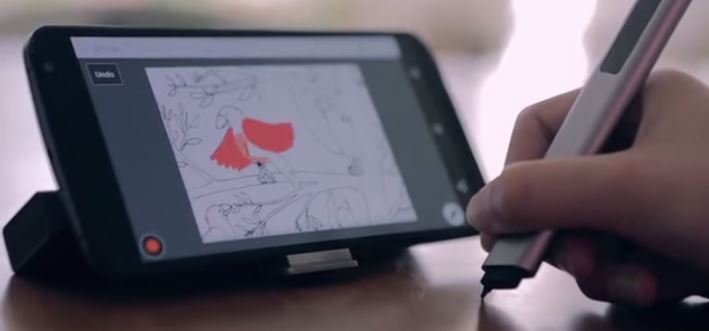Israeli company introduces Phree, a mobile input device intended to bring handwriting back into our digital interactions.
Patiently waiting more than a decade until the digital world caught up to their cool technology, three Israeli friends are introducing Phree, a unique “smart pen” that tracks handwriting on virtually any surface and displays it on any Bluetooth-connected smartphone, tablet, computer, TV or smartwatch in high-definition.
This isn’t just another stylus. Phree uses patented laser technology to deliver what the inventors call an unprecedented level of motion-tracking accuracy.
When it starts shipping in March 2016, the device will allow users to take notes, record thoughts, annotate websites, documents and photos, and send text messages with emojis — without touching the screen and even without the device in view.
Compatible with Office, OneNote, EverNote, Acrobat, Google Handwriting Keyboard, ViberChat and similar handwriting-recognition software and apps, Phree promises to free the user of clunky typing interfaces.
“We live in a world of screens that we’ve come to rely on for everything from our work to our personal lives, but oftentimes our imaginations are confined by these same screens,” says Gilad Lederer, co-CEO and cofounder of OTM Technologies. “Phree goes beyond the screen to help your imagination go digital, free of constraints.”
More than $1 million crowdfunded
But wait a sec – do people really want to go back to writing by hand? Do we even remember how?
Apparently the answer is yes, judging by the extraordinary response to a Kickstarter campaign for Phree that hit the $100,000 target in less than 24 hours and ended up raising $1,065,761 by the June 26 deadline.
Phree plugs into a recognized trend that may seem counter-intuitive: As we become ever more digitally connected, we crave a return to handwriting.
Smartphones, wearables and IoT devices have revolutionized how we receive information, yet transmitting information via keyboard is frustratingly awkward. That’s why Google and Microsoft are adding handwriting-recognition platforms to Android and Windows 10 devices, respectively.
“We all we know the limitations of smartphones,” Lederer tells ISRAEL21c. “I’m holding a computer in my pocket that’s much more powerful than my PC at home, but I can’t use it for work. So we had the solution ready.”
Lederer and cofounders Opher and Uri Kinrot (they’re brothers) had long ago invested much time, effort and money in developing an optical translation measurement (OTM) sensor that uses 3D laser to measure relative motion on nearly any surface, producing a crisp, natural digital capture of handwriting in high-resolution.
It was a product before its time, so they shelved it with the confidence that the coming digital revolution would make it relevant.
“We realized we had found the key to measuring human handwriting motions, but there was no market for it more than 10 years ago. We knew things would change,” says Lederer.
In the past year, OTM Technologies took the sensor down from the shelf and hired renowned Israeli industrial designer Elisha Tal from Innovation to Design (I2D) to fashion it into a sleek and enticing consumer product. (Tal is the creative genius behind the Palm V, the Landa nanographic printing press and SodaStream, among other hit products.)
Marketing and branding guru Eitan Chitayat, head of the Tel Aviv-based Natie Agency, gave the product a name and a profile consumers could easily grasp.
“The name ‘Phree’ stood out to us as soon as we came up with it because it explicitly and implicitly stands out as an unusual and easy-to-pronounce spelling of ‘free.’ It memorably highlights how this tool frees you from the screen, and works in harmony with the tagline ‘Make the world your paper.’ And that’s the positioning we delivered,” Chitayat tells ISRAEL21c. “We’re all very happy at Natie to be part of this story’s success.”
OTM Technologies raised seed capital from private investors including former Skype chairman Michael Von Swaaij, who went to business school with Lederer in France. “We are now going for Round A funding in addition to crowdfunding, in order to accelerate our path to market,” says Lederer.
He and his cofounders are all 1980s graduates of Talpiot, an elite IDF physics and mathematics training program. Their original technology was to be built inside an optical mouse. They signed agreements with Logitech and Apple, but both projects failed due to a problem with an electronic chip provided by another contractor.
“Though we lost the market for optical mice, we knew nobody could do Phree,” says Lederer.
The product even functions as a headset and has an integrated screen for sending and receiving brief texts. The founders say Phree could also be used for biometric identification.
“The real-world applications for Phree are limitless and we’re excited to see how the development community finds new ways to incorporate it into their own work once they get their hands on it,” said Opher Kinrot. “From being able to truly work from a coffee shop to interacting in virtual reality, we foresee Phree becoming a vital part of one’s work and entertainment experiences.”
For more information, click here.
By: Abigail Klein Leichman, israel21c.org
Click here for the latest Good News from Israel.
